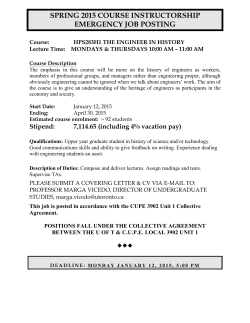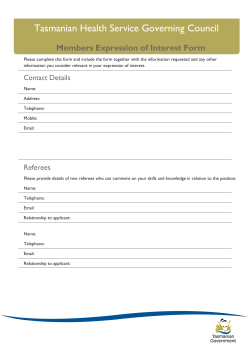
WHITE PAPER - The TAS Group
The Account Planning Process WHITE PAPER The Account Planning Process INTRODUCTION The TAS Group has been developing and sharing Account Management best practices since the late 1980’s. Our Account Planning and Management methodologies are in use in some of the world’s most admired selling organizations, and it is their insight that has helped shape what we deliver. This White Paper addresses the Account Planning Process. It covers selecting the best opportunities to pursue, preparing, executing and monitoring an Account Plan, and how to use the Account Plan to improve sales performance. To learn more about The TAS Group sales methodologies, processes and solutions, we urge you to get in touch with us directly. You can do this via info@thetasgroup.com or thetasgroup.com ACCOUNT PLANNING IS A TEAM SPORT Aristotle was by common consent one of the cleverest people to have lived, and he is often credited with originating the saying that the whole is greater than the sum of its parts. This holds true for team sports and in fact Account Planning is no different. Put another way, when you put the abilities of an Account Team together, their collective success exceeds the sum of their individual contributions. Brainstorming, discussion, creativity and collaboration all combine to make the account team a powerful entity for action, change and progress. So who should be in your Account Team? What’s the right blend of people? Besides the Account Manager(s), Solutions, Marketing, Pre-Sales, Bid Management, and Finance all have a role to play in the Account Planning process, but already your team is getting unwieldy and coordination becomes increasingly challenging. In our experience, Account Planning is not done effectively. It is typically reactive, with unprepared resources brought in at the last minute, and that’s not a good recipe. Share this White Paper! Account Planning takes a lot of time and effort, and at first glance there seem to be good reasons why: it’s time consuming, it decreases selling time, people don’t always want to be held accountable, and plans change, which has a tendency to waste the effort. These are the excuses of the organization that is too busy to take stock, is tactical over strategic, short term over long term, and is rushing towards failure. After all, to paraphrase the well known comment from John Preston of Boston College, the great thing about not planning is that failing comes as a complete surprise and is not preceded by a period of worry and depression. Following an Account Planning process brings order to the often chaotic world of the sales organization, and the benefits contribute directly to sales success: sales opportunities are better qualified so that teams pursue the right deals; Team resources are better utilized to increase productivity and reduce wasted effort; Team efforts are better coordinated to increase the chances of winning. Copyright © The TAS Group. All rights reserved. 1 ACCOUNT PLANNING – SELECTING THE BEST OPPORTUNITIES FOR THE TEAM Good, effective selling organizations use both sales methodology and sales process in their daily selling efforts. Account Management is concerned with the creation of opportunities, turning ideas, research or inbound leads into opportunities. Opportunity Management is about winning as many of the right – that is, properly qualified – opportunities as possible. Performance Management is about maximizing revenue from the opportunities. Sales process is the series of selling activities that an organization performs to align itself with the buying activities that the customer wants to perform, through time, as opportunities work their way through the funnel. You can only win a percentage of the opportunities put in front of you, so the creation and finding of opportunities are crucial, since they determine the size of the pie you can win. Account Management Opportunity Management Leads > Opportunities Opportunities > Close Performance Management Revenue > Increased $ Opportunities TIME YOUR SALES PROCESS Figure 1: Methodology and Process in the Selling Organization So if Account Management is about creation, Account Planning is about selection, and the Account Planning process enables Account teams to be proactive. This means identifying the opportunities your team should pursue, rather than working every single opportunity that comes along. It also implies confidence in your decisions not to pursue the Share this White Paper! wrong deals, resisting the temptation to chase everything. Then your team can get specific on the chosen deals, which is the domain of opportunity management. Why is selecting the right opportunities so important? Surely it’s about winning any opportunities you can? The right opportunity is the one where the return exceeds the expenditure outlaid to win, deliver and service them by an acceptable amount, and where the fit is good between the customer’s requirements and the unique business value you can bring. To answer this vexing question, you need to understand how long it takes to win an average deal in your organization, and how long to lose one. You might feel that where it takes 6 months to win a deal, it only takes a second to lose a deal. In a recent TAS Group webinar, over 96% of an audience of over 130 who voted admitted that they have forecasted a deal that didn’t close, ever. Furthermore, research from The TAS Group shows that it takes 50% longer to lose a deal than win one, and those are generally the deals you should never have contested in the first place. Imagine the money and resources you are committing for 9 months, working on a wrong deal, only to lose it, when you could have effectively won the right deal and be half way towards closing the next right deal in the same time frame. Selecting the right opportunities is a 3-step process. First, define a targeted subset that you will address; second, uncover potential opportunities to prioritize; third, create a plan to purse those opportunities. You should start by considering the universe of places that you could sell into your Account. That’s the easy part. Then you have to do your homework. You need to define a targeted subset of the entire account. This involves learning which areas of the business are the highest priority for your customer, the areas in which they are investing. These are the important projects where they will look to speculate – with you ideally – to accumulate. Often, Account teams only identify areas where current relationships exist, but these might not be where the opportunities are, otherwise you would probably know about them. Account teams need to study the Account to figure out the ideal Business and Service Units to target. Copyright © The TAS Group. All rights reserved. 2 FUTURE Once identified, these areas need to be plotted against a twoby-two matrix, as shown below. Your two key axes should be current revenue to you, and future revenue potential. In terms of prioritizing, A targets are those which have high current revenue and high potential revenue. B targets have low current revenue and high potential revenue. C targets have high current revenue and also low potential revenue. And D targets, well, you get the picture; that’s not where you want to be investing your team’s precious resources. Account Planning is all about the future; you can’t alter the past, and the present is what it is. B A D C CURRENT The way to uncover potential opportunities is to focus on your customer. What are their objectives? What do they want to accomplish? Then you need to consider the challenges they face in achieving their objectives. What types of problems are preventing them from achieving them? The key to finding the right projects is to learn the motivation that would cause the customer to act. What are the consequences to them of inaction? What is compelling them to act? From here, Account teams can identify which challenges could become projects. How could you help them overcome these hurdles? This is where your team once again brainstorms on how you can help the customer address these challenges. Remember to look beyond the quarter, or even beyond the year, into the future. With global or remote Account teams, it can be a challenge getting together as a team, either physically or virtually, to do the brainstorming. The TAS Group’s Dealmaker platform makes it easier for Account teams to collaborate on this critical part of the Account Planning process. In the sample screenshot below, you can see how it is possible to record and map out the Account goal (in light blue), the business drivers pressuring the customer (in mid blue), the initiatives they could deploy to address those drivers (in pink), and how these initiatives are manifested in critical success factors (in yellow). This process can be developed and its output shared with the Account team in real time. Figure 2 : Prioritizing Potential Opportunities As you may have realized, this exercise occupies the research and brainstorming efforts of the entire team, but the time invested will pay your Account team back many times over in the medium to long term. With this good foundation in place, you can start to build the fabric of success with your potential opportunities. The critical word is potential here, and gets to the real power of Account Management and the Account Planning process. Potential opportunities are opportunities that you have uncovered, and which may not yet exist in the mind of your customer. At this point, they may not have identified them as projects. But they are in addition to all the projects that your customer has already identified, what we term current opportunities, and the value of all these potential opportunities is down to your and your Account team’s efforts and the great homework you have done on the Account so far. Share this White Paper! Figure 3 : Business Strategy Map in Dealmaker Notice that the value for the team is that they are forced to focus on the customer, and their issues, not the vendor solutions. Once the customer-focused work is done, you can then start to marry your expertise to the customer projects, in the form of the potential opportunities. Copyright © The TAS Group. All rights reserved. 3 PREPARING, EXECUTING AND MONITORING THE ACCOUNT PLAN Preparing your Account Plan is about establishing the facts on your customer Account – which is all about them - and creating your plan, which is all about you. First, who are they? Who are the key people in the Business and Services Units that you need to get to? Who do they report to? Where are they in the political structure? Who wields the power? Who influences whom? What sort of people are they? Using an application like Dealmaker, which sits transparently inside your CRM system, organization charts can be quickly created with detail on each individual, so that teams can have productive discussions and make specific input. The OSA framework makes your team think in specifics. The Objective must explain what the team intends to accomplish. It must be a SMART objective – Specific, Measureable, Achievable, Relevant and-Time bound. The Strategy describes in detail how the team will accomplish the Objective, and the individual underpinning Actions should be specific as well. Dealmaker makes it easy for remote teams to brainstorm and capture specific actions by each team member. You no longer have to run one of those Account Plan calls that last an hour or more and at the end you all hang up, you’ve had a good discussion, but nothing specific is captured and no one knows exactly what is going to be accomplished. When it comes to successfully executing the plan, you must capture Actions that support the strategy. “Conduct a meeting to learn about customer challenges” is not a good Action. You need to identify who you will speak to or meet with, what the outcome should be, and what you will accomplish. A better Action is: “Meet with the CFO to motivate him to become a supporter of our $200k solution. We will use the CTO to communicate our unique value of providing 24/7 service globally.” Figure 4 : Mapping out Who is in the Organization Structure As mentioned before, facts refer to your customer, which means focusing on their objectives, their challenges and their motivation to act. Then your team can start to create its plan, and the vehicle for this is the ‘OSA’, composed of Objectives, Strategies and Actions. The OSA is a critical success factor to planning, because unless it is done well, it is of no value to the team. Customer FACTS: All About Them Objectives Challenges Motivation to Act Your PLAN: All About You Objectives Strategies Once the Account team members start executing on the Actions, the team can start to monitor the plan. This necessitates communicating the results, the progress made, and then revising the plan accordingly. The Account Plan should be a dynamic document that is constantly updated, not something you do once, leave on the shelf to gather dust for 11 months and revisit when you next have to do a plan. For example, “Jane, you were supposed to conduct a meeting with the CFO, leveraging the CTO. What happened? What should we do next?” Devising and communicating specific actions enables your teams to have productive discussions around “what we said we’d do” and “what we did”, and so revise the plan. It is vital you ensure that these Actions are strategic in nature, not tactical. If Actions become tactical, like “do a proposal”, the plan will quickly become anodyne and tedious and teams will cease to see the value. Actions Figure 5 : The Basis of Your Account Plan Share this White Paper! Copyright © The TAS Group. All rights reserved. 4 Figure 6 : Capturing OSAs in the Account Plan with Dealmaker USING ACCOUNT PLANS TO IMPROVE PERFORMANCE Three steps are key to making Account Plans the catalyst for improving Account Team performance. First, you should set expectations for the Account Plan review. Second you should review the plan. Third, you should provide feedback on the plan and coach to greater success. Setting expectations for the review is a simple but essential task. You should decide the following: Who will be involved as presenters and reviewers of the plan? What timeframes will we adhere to? Who will be the appointed note-taker? What is the intended outcome of this review? This puts in place a repeatable formula to get the most out of the team. Reviewing the plan is generally split into 3 discrete elements. Presenting the plan, clarifying it, and improving it. We recommend you allocate 40 minutes to do an Account Plan review. For the first 15 minutes the team presents the plan, with no interruptions, while the reviewers listen and taken notes. For the next 10 minutes the reviewers ask questions, Share this White Paper! to test their understanding and to get additional information to build the picture. The last 15 minutes should be spent identifying risks and recommendations, and then presenting them back to the team. After the Account Plan review has been conducted, how should sales leaders provide feedback and deliver useful sales coaching? It may seem obvious, but diplomacy is an essential skill for the sales leader. This means reviewers must first compliment the team on those aspects of the plan preparation and presentation that they have done well. Then they can provide insight to improve the plan and coach teams and individuals on how to get this done. Second, managers should take the opportunity to define specific skill improvement to address shortcomings or gaps in skillsets, such as selling to executives for example. This could be specific for an individual or for an entire team. Finally, leadership teams must identify next steps, to secure progress and keep the momentum going. Copyright © The TAS Group. All rights reserved. 5 SUMMARY In summary, the Account Planning Process covers selection of the best opportunities for the team, preparation, execution and monitoring of the Account Plan, and use of the Account Plan to improve the performance of the Account team. Opportunity selection centers around a targeted subset, uncovering potential opportunities and establishing an Account Plan for delivering on those opportunities. Preparing and executing Account Plans involves dealing with facts, people, actions and outcomes, while monitoring Share this White Paper! Account Plans ensures that results are measured against targets, communicated to all stakeholders, and targets are revised accordingly. Account Plans provide the framework for team improvement through reviewing, feedback and coaching. To find out more about The TAS Group, Dealmaker or Account Management, please contact us at info@thetasgroup.com. Copyright © The TAS Group. All rights reserved. 6 ABOUT THE TAS GROUP The TAS Group helps progressive sales organizations increase their sales velocity resulting in higher win rates, bigger deals, shorter sales cycles, and more qualified deals in the pipeline. Our unique value is deep methodology embedded within intelligent Dealmaker software, 100% native in Salesforce. Smart coaching, delivered just-in-time, improves sales performance and accelerates sales results. We have changed the paradigm of improving sales effectiveness from traditional sales training to delivering sales methodology and insights when and where the sales person is working a sales opportunity. For more information visit www.thetasgroup.com Copyright © The TAS Group. All rights reserved. This briefing is for customer use only and no usage rights are conveyed. Nothing herein may be reproduced in any form without written permission of The TAS Group.
© Copyright 2025














